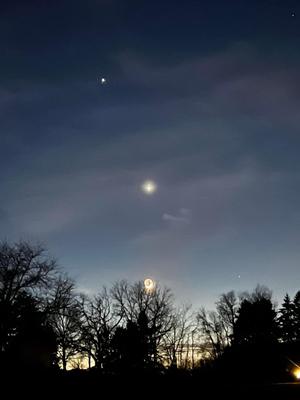Glossary term: Conjunction
Description: From the perspective of an observer on Earth, when two astronomical objects appear to be in close proximity in the sky they are said to be in conjunction. The conjunction does not need to be actually visible – for instance, the Moon and the Sun are approximately lined up whenever there is a new Moon, but we cannot see the Moon under those conditions, unless there is a solar eclipse. In that case, and whenever a conjunction is so close that one object appears to cover the other, astronomers would describe it as a transit or eclipse.
Related Terms:
See this term in other languages
Term and definition status: This term and its definition have been approved by a research astronomer and a teacher
The OAE Multilingual Glossary is a project of the IAU Office of Astronomy for Education (OAE) in collaboration with the IAU Office of Astronomy Outreach (OAO). The terms and definitions were chosen, written and reviewed by a collective effort from the OAE, the OAE Centers and Nodes, the OAE National Astronomy Education Coordinators (NAECs) and other volunteers. You can find a full list of credits here. All glossary terms and their definitions are released under a Creative Commons CC BY-4.0 license and should be credited to "IAU OAE".
If you notice a factual error in this glossary definition then please get in touch.
Related Media
Jupiter, Venus, Moon Conjunction
Credit: Joslynn Appel/IAU OAE (CC BY 4.0)
License: CC-BY-4.0 Creative Commons Attribution 4.0 International (CC BY 4.0) icons
Moon-Mercury-Pleiades Conjunction
Credit: Giulio Colombo/ IAU OAE
License: CC-BY-4.0 Creative Commons Attribution 4.0 International (CC BY 4.0) icons










